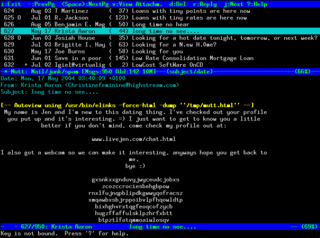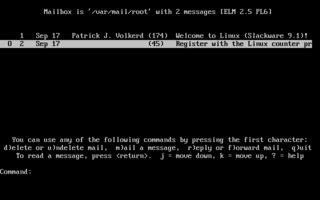Related Research Articles

Electronic mail is a method of transmitting and receiving messages using electronic devices. It was conceived in the late–20th century as the digital version of, or counterpart to, mail. Email is a ubiquitous and very widely used communication medium; in current use, an email address is often treated as a basic and necessary part of many processes in business, commerce, government, education, entertainment, and other spheres of daily life in most countries.
Multipurpose Internet Mail Extensions (MIME) is an Internet standard that extends the format of email messages to support text in character sets other than ASCII, as well as attachments of audio, video, images, and application programs. Message bodies may consist of multiple parts, and header information may be specified in non-ASCII character sets. Email messages with MIME formatting are typically transmitted with standard protocols, such as the Simple Mail Transfer Protocol (SMTP), the Post Office Protocol (POP), and the Internet Message Access Protocol (IMAP).
Pretty Good Privacy (PGP) is an encryption program that provides cryptographic privacy and authentication for data communication. PGP is used for signing, encrypting, and decrypting texts, e-mails, files, directories, and whole disk partitions and to increase the security of e-mail communications. Phil Zimmermann developed PGP in 1991.
The Rich Text Format is a proprietary document file format with published specification developed by Microsoft Corporation from 1987 until 2008 for cross-platform document interchange with Microsoft products. Prior to 2008, Microsoft published updated specifications for RTF with major revisions of Microsoft Word and Office versions.
The Simple Mail Transfer Protocol (SMTP) is an Internet standard communication protocol for electronic mail transmission. Mail servers and other message transfer agents use SMTP to send and receive mail messages. User-level email clients typically use SMTP only for sending messages to a mail server for relaying, and typically submit outgoing email to the mail server on port 587 or 465 per RFC 8314. For retrieving messages, IMAP is standard, but proprietary servers also often implement proprietary protocols, e.g., Exchange ActiveSync.
Mbox is a generic term for a family of related file formats used for holding collections of email messages. It was first implemented in Fifth Edition Unix.
vCard, also known as VCF, is a file format standard for electronic business cards. vCards can be attached to e-mail messages, sent via Multimedia Messaging Service (MMS), on the World Wide Web, instant messaging, NFC or through QR code. They can contain name and address information, phone numbers, e-mail addresses, URLs, logos, photographs, and audio clips.
The Internet Calendaring and Scheduling Core Object Specification (iCalendar) is a media type which allows users to store and exchange calendaring and scheduling information such as events, to-dos, journal entries, and free/busy information, and together with its associated standards has been a cornerstone of the standardization and interoperability of digital calendars across different vendors. Files formatted according to the specification usually have an extension of .ics. With supporting software, such as an email reader or calendar application, recipients of an iCalendar data file can respond to the sender easily or counter-propose another meeting date/time. The file format is specified in a proposed Internet standard for calendar data exchange. The standard and file type are sometimes referred to as "iCal", which was the name of the Apple Inc. calendar program until 2012, which provides one of the implementations of the standard.

Mutt is a text-based email client for Unix-like systems. It was originally written by Michael Elkins in 1995 and released under the GNU General Public License version 2 or any later version.
S/MIME is a standard for public-key encryption and signing of MIME data. S/MIME is on an IETF standards track and defined in a number of documents, most importantly RFC 8551. It was originally developed by RSA Data Security, and the original specification used the IETF MIME specification with the de facto industry standard PKCS #7 secure message format. Change control to S/MIME has since been vested in the IETF, and the specification is now layered on Cryptographic Message Syntax (CMS), an IETF specification that is identical in most respects with PKCS #7. S/MIME functionality is built into the majority of modern email software and interoperates between them. Since it is built on CMS, MIME can also hold an advanced digital signature.
MHTML, an initialism of "MIME encapsulation of aggregate HTML documents", is a Web archive file format used to combine, in a single computer file, the HTML code and its companion resources that are represented by external hyperlinks in the web page's HTML code. The content of an MHTML file is encoded using the same techniques that were first developed for HTML email messages, using the MIME content type multipart/related. MHTML files use an .mhtml or .mht filename extension.
The following tables compare general and technical features of notable email client programs.
Many email clients now offer some support for Unicode. Some clients will automatically choose between a legacy encoding and Unicode depending on the mail's content, either automatically or when the user requests it.
HTML email is the use of a subset of HTML to provide formatting and semantic markup capabilities in email that are not available with plain text: Text can be linked without displaying a URL, or breaking long URLs into multiple pieces. Text is wrapped to fit the width of the viewing window, rather than uniformly breaking each line at 78 characters. It allows in-line inclusion of images, tables, as well as diagrams or mathematical formulae as images, which are otherwise difficult to convey.
A media type is a two-part identifier for file formats and format contents transmitted on the Internet. Their purpose is somewhat similar to file extensions in that they identify the intended data format. The Internet Assigned Numbers Authority (IANA) is the official authority for the standardization and publication of these classifications. Media types were originally defined in Request for Comments RFC 2045 (MIME) Part One: Format of Internet Message Bodies in November 1996 as a part of the MIME specification, for denoting type of email message content and attachments; hence the original name, MIME type. Media types are also used by other internet protocols such as HTTP and document file formats such as HTML, for similar purposes.
The Abuse Reporting Format (ARF) also known as the Messaging Abuse Reporting Format (MARF) is a standard format for reporting spam via email.
DNS-based Authentication of Named Entities (DANE) is an Internet security protocol to allow X.509 digital certificates, commonly used for Transport Layer Security (TLS), to be bound to domain names using Domain Name System Security Extensions (DNSSEC).

Efail, also written EFAIL, is a security hole in email systems with which content can be transmitted in encrypted form. This gap allows attackers to access the decrypted content of an email if it contains active content like HTML or JavaScript, or if loading of external content has been enabled in the client. Affected email clients include Gmail, Apple Mail, and Microsoft Outlook.

A text-based email client is an email client with its user interface being text-based, occupying a whole terminal screen. Other kind of email clients are GUI-based or Web-based, see Webmail.
References
- ↑ "Why HTML is Inappropriate for E-Mail". www.avernus.com.
- ↑ "EFAIL". efail.de. Retrieved 2021-01-05.
- ↑ "gnu.org". www.gnu.org.
- ↑ "The Mutt E-Mail Client: Mutt's MIME Support". Archived from the original on 2013-03-08. Retrieved 2013-02-26.